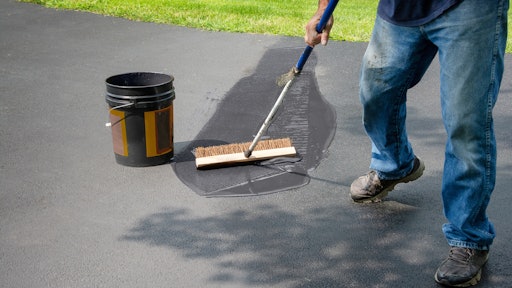
Contractors in the northern climates have fought weather, season to season. Mother Nature has dealt many sealcoating contractors another blow as the colder weather begins to really set in.
Where record setting rain was the issue through much of May and June and a derecho that raced 700 miles across the central United States from Iowa to Ohio, bringing significant damage, has left sealcoating contractors with more sealer than normal at the end of the season.
And where disposing of small amounts is typical, contractors who took delivery of significant amounts of sealer in expectation of a late-season push are faced with a significant hit to their bottom line if they have to throw the unused sealer away. And the disposal of sealer, itself, is not easy. It is a costly proposition.
Girish Dubey, president of STAR Inc. Columbus, OH, said there are steps contractors can take to protect the unused sealer so they can use it next spring.
"The most important point is to save it from freezing," Dubey says. "It must be stored in a heated warehouse and maintained at a minimum temperature of between 45°F and 50°F."
Dubey says it's important to remove the sealer from any truck it's now in, so contractors should place it in a storage tank inside where the heat can be controlled.
"Then the sealer must be stirred on regular basis. Dubey says a thorough stirring for 30-45 minutes every other day is sufficient.
He says sealer purchased in 55-gal. drums can also be kept over the winter provided precautions are taken. Drums must be kept tightly closed, and unopened drums should not be opened for any reason.
"Any settling or separation can be re-mixed when the drums are re-opened for application," he says.
Dubey says contractors storing asphalt-based sealer stored in closed drums should keep a close eye on the drums for any signs of "bulging," the result of gassing caused by bacterial spoilage of the material in the drum.
"If you notice any bulging handle those drums with great care, observing all regulations for personal protection," Dubey says.
Ask the manufacturer of the sealer, if the material is protected with preservatives, also called "bug killers".
Dubey says contractors can protect sealer from bacterial spoilage.
He says coal tar-based sealer can develop an odor of Hydrogen Sulfide (rotten egg smell), which results from a reduction of sulfur in the material by sulfide-reducing bacteria in the coal tar. Dubey says contractors can correct this problem by adding a liquid biocide at a rate of roughly 1 - 1.5 gal. of biocide per 1000 gal. of sealer.
He says asphalt-based sealer is prone to bacterial spoilage, which actually breaks down the asphalt and destroys the sealer. Contractors can detect such spoilage if they notice foaming of the material or volume expansion, usually indicated by bulging of the container. The sealer may or may not smell bad.
"It is essential to protect all asphalt-based products with an preservative biocide at a rate of 1.5-2.0 gal. per 1,000 gal. of sealer," Dubey says.
Dubey says that when properly cared for both asphalt-based sealer and coal-tar-based sealer will last the winter and can be used the next season.
"Even spoiled sealer that has been treated can be used the next season as long as it has been properly treated," Dubey says. "But contractors should not mix spoiled sealer with fresh sealer. Use the spoiled sealer all by itself on any jobs."





























